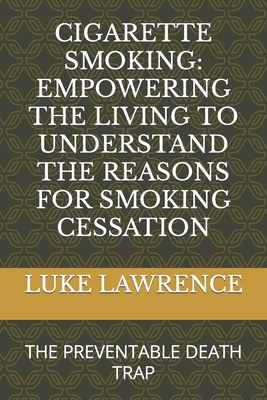You are here
Back to topCigarette Smoking: Empowering the Living to Understand the Reasons for Smoking Cessation: The Preventable Death Trap (Paperback)
$20.00
Email or call for price
Email or call for price
Description
Cigarette smoking is a widespread and persistent public health concern with significant consequences on individuals, communities and society at large. This book delves into the multifaceted aspects of cigarette smoking, covering its historical context, health complications, socioeconomic implications and cessation strategies.
The origin of tobacco use can be traced back to indigenous cultures in the Americas, where it was used for ceremonial and medicinal purposes.The introduction of tobacco to Europe by explorers led to its global adoption and commercialization. The invention of the cigarette rolling machine in the late 19th century revolutionized tobacco consumption and facilitated mass production. Advertising and marketing strategies by tobacco companies played crucial roles in popularizing cigarettes.
The Surgeon General's Report in 1964 brought to the fore the need of acknowledging the health hazards of smoking, leading to increased regulation.The emergence of anti-smoking campaigns and advocacy groups further influenced public perception and policy on smoking.
Smoking is the leading cause of preventable deaths globally. This is primarily due to its association with lung cancer, chronic obstructive pulmonary disease (COPD) and other respiratory disorders. Cigarette smoke contains harmful chemicals that adversely affect major organs of the body including cardiovascular system, mouth, throat, esophagus, pancreas, bladder and cervix where it promotes high blood pressure, stroke and cancers. Maternal smoking during pregnancy is associated with low birth weight, preterm birth and developmental challenges in offspring. Some of these harmful effects are equally expressed on non-smokers due to secondhand smoke exposure.
Some of the socioeconomic toll of smoking encompasses education and healthcare costs, low productivity, relationship deficit and premature mortality, affecting individuals, families and governments. Cigarette production, distribution and disposal contribute to environmental degradation through deforestation, pollution and litter.
The key components of smoking cessation and public health intervention programs involve behavioral interventions, pharmacotherapy and counseling. Access to effective cessation resources and support networks is essential for successful quit attempts.
Policy interventions through legislation, taxation and regulatory measures have proven effective in reducing smoking rates and protecting public health. Smoke-free policies in public spaces and workplaces have contributed to decreasing exposure to secondhand smoke.
In conclusion, the understanding of the historical context, health effects, socioeconomic implications and effective cessation strategies is imperative in combating this public health challenge. Sustained efforts in research, education and policy implementation are essential in preparing a smoke-free future for generations to come.
